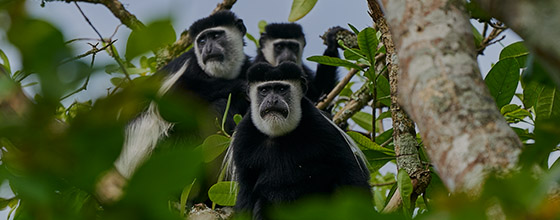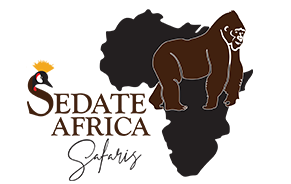
Kibale National Park | Chimps Tracking Uganda
This largely forested park, 795km2 in area, is best known for its number and variety of primates, which include Uganda’s largest population of chimpanzees. Kibale’s varied altitude supports different types of habitat ranging from tropical forest to woodland and savannah on the rift valley floor. Kibale is one of Africa’s foremost research sites for tropical forest biology. East of the Rwenzori Mountain, the landscape is dotted with volcanic crater lakes and carpeted with tea plantations and tropical forest. The largest tract of forest is protected within the 795km2 Kibale National Park. Established as a forest reserve in the 1940s, Kibale was upgraded to national park status in recognition of a biodiversity that includes 350 tree species, 71 species of mammal and 370 bird species.
The park is best known for its primates which include chimpanzee, the localized red colobus and L’Hoest monkeys. The northern and central part of Kibale lies on the Fort Portal plateau, 1590m above sea level, and is mostly forested. The park extends south through bushy vegetation on the rift valley escarpment before dropping down to the grasslands of the rift valley floor, 500m below. There are two tourism sites in Kibale NP. The main hub is at Kanyanchu, 35km southeast of Fort Portal on a newly tarmacked road leading to Kamwenge and Ibanda. A secondary site is at Sebitoli, 16km east of Fort Portal on the Kampala road.
WILDLIFE
An impressive list of 13 primate species include Uganda’s largest population of chimpanzees – an estimated 1450. Other notable primates are the nocturnal bushbaby and potto; the L’Hoest’s Monkey, which is endemic to the Albertine Rift region; East Africa’s largest population of the threatened red colobus monkey; and Uganda’s only endemic monkey, the Uganda mangabey (Lophocebus ugandae) Long mistaken for the common grey-cheeked mangabey (L. albigena), this unique inhabitant of Kibale was identified as a distinct species in 2007. Other large mammals, such as elephant, buffalo and giant forest hog are present but are rarely seen. The park boasts 372 species of bird including six that are endemic to the Albertine Rift region, namely blackcapped apalis, collared apalis, blue-headed sunbird, dusky crimsonwing, purple-breasted sunbird and redfaced woodland warbler, Other‘ ‘Kibale specials’ include the African pitta, green breasted pitta, black bee eater, eastern nicator, yellow rumped tinkerbird, Kibale ground thrush, brown-breasted alethe, blue breasted kingfisher, Abyssinian ground-thrush and the crowned eagle.
LOCAL PEOPLE
The people living around the park are mainly indigenous Batoro and Bakiga migrants from the densely populated south western part of Uganda. The Batooro take pride in the cultural heritage of their kingdom, a scion of the ancient kingdoms of Africa’s Great Lakes region. The Omukama (the Toro king) and the kingdom embody the traditional and cultural values of Batoro while the Bakiga immigrants still preserve their tradition and culture through folklore, dance and language.
Access to Kibale National Park
Road
The main tourism hub at Kanyanchu, on the newly tarmacked Fort Portal-Ibanda road, can be reached from Kampala by a number of routes, all on surfaced roads. The most direct (335km) is via Fort Portal, 35km to the north. The park can also be reached from the south via Lyantonde and Ibanda (392km), Mbarara and Ibanda (405km) and Mbarara, Kasese and Fort Portal (525km). All of these routes allow a break in Lake Mburo NP while the long Kasese route also encourages a night in Queen Elizabeth NP. Air Kibale National Park has access to two airstrips: Nyakisharara, near Mbarara (100km on tarmac) and Kasese (60km on surfaced and dirt roads).
CLIMATE
The climate is generally pleasant with a mean annual temperature range of 14-27oC. Temperatures are highest on the hot and dry rift valley floor in the south of the park. The northern, forested part of the park is the wettest area, receiving a mean annual rainfall of up to 1,700 mm mostly during March-May and September-November.
WHEN TO VISIT
The park can be visited any time of the year but be prepared for afternoon rain during the wet months.
ACCOMMODATION
Accommodation within the national park is limited to an upmarket lodge at Kanyanchu and budget cottages run by UWA at Sebitoli. A wide range of additional accommodation, catering for all budgets is found around Bigodi village, to the south of Kanyanchu, and in the Ndali-Kasenda Crater Area to the west. Recent road improvements mean that early morning activities in Kibale can easily be reached from hotels in and around Fort Portal.
AROUND THE PARK
Kibale is surrounded by a wealth of additional attractions. Visitors should take time to explore the scenic crater lakes along the western margin of the park, tour a tea factory, drive down onto the rift valley floor to the hot springs in Semuliki NP, hike on the Rwenzori mountain, and view big game on the grasslands of Queen Elizabeth National Park.
Park activities should be booked and paid for at UWA Headquarters in Kampala or at the Kibale NP Office at Isunga. Bookings, but not payment, can also be made at the Kibale Conservation Area Office in Fort Portal (see contacts at end).
PRIMATE WALK (CHIMPANZEE TRACKING)
The perennially popular primate walk provides the chance to observe chimpanzees in their natural habitat. Kanyanchu’s groups are accustomed to human presence – some have been observed for over 25 years – and the chance of locating them is over 90%. Walks leave Kanyanchu Visitor Centre at 08.00, 11.00 and 14.00 and last between 2-5 hours. Early arrival to allow for registration and briefing is recommended. Contact time with chimpanzees is limited to one hour; group size is limited to six visitors; participants must be aged 16 or over. Advance booking is essential.
CHIMPANZEE HABITUATION EXPERIENCE
The Chimpanzee Habituation Experience (CHEX) enables visitors to accompany researchers and habituators into the forest. The chimpanzee groups involved are less accustomed to human presence than those visited on the Primate Walk and following and viewing them is both exciting and challenging. The CHEX sessions is available on a full or half day basis starting at 0630. Advance booking for this activity is required.
NATURE WALKS
A Nature Walk is an opportunity to enjoy one of East Africa’s most beautiful and varied forests without pressure to locate chimpanzees or tick off a dozen ‘Kibale specials’ on the birdlist. This is also an ideal activity for young visitors unable to accompany relatives on the Primate Walk. Two hour Nature Walks begin at 08.00, 10.00 and 14.00 from Kanyanchu Tourist Centre.
NIGHT WALKS
Enter the forest after dark to search for nocturnal creatures such as galagos, pottos and bushbabies. Night walks are conducted from 19.30-22.00 daily.
BIRDING
A birdlist of 372 forest, grassland and swamp species, including local endemics and Central Africa ‘specials’ makes Kibale a popular destination for birders. Forest birds can be sought, with the help of experienced UWA guides, on the forest trails at Kanyanchu and Sebitoli tourism sites. This experience should be combined with a visit to Bigodi Wetland Sanctuary to add forest edge and swamp specials to the list. This popular, communityrun attraction lies just outside the park, 5km south of Kanyanchu.
